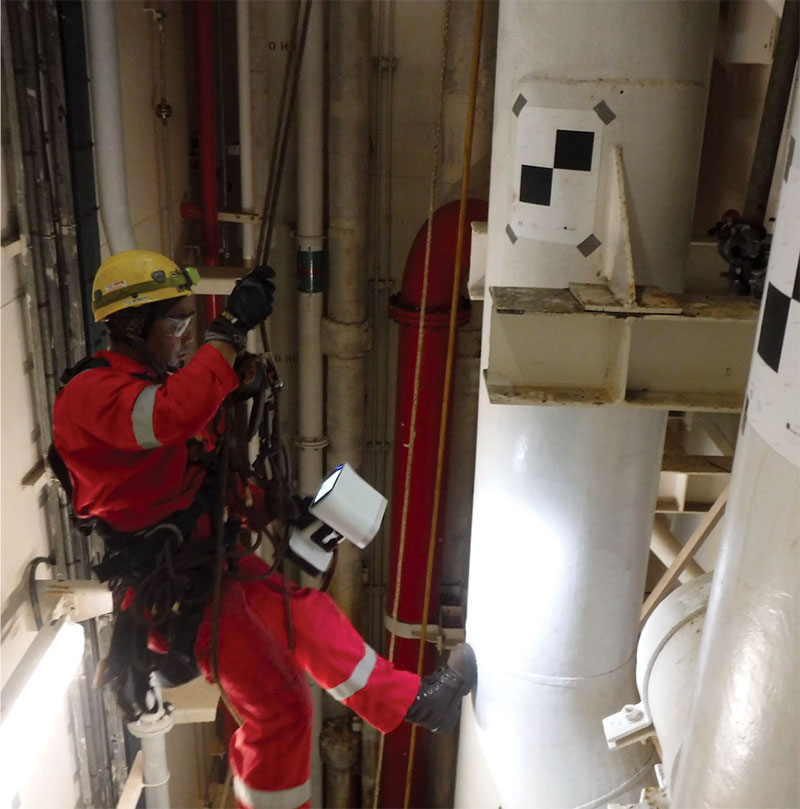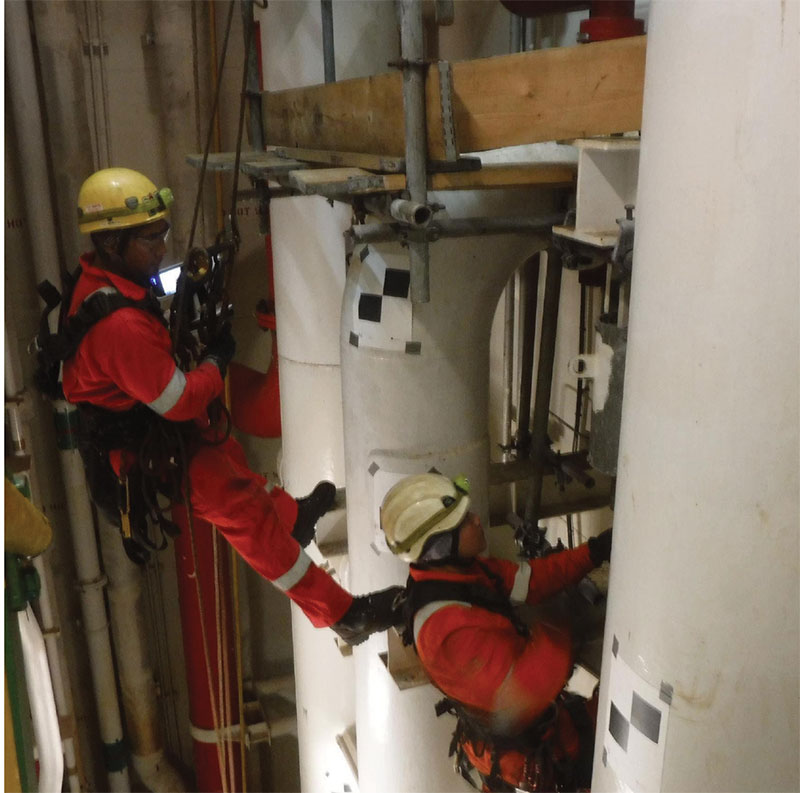May 2020, Vol. 247, No. 5
Features
3-D Scanning Used to Fabricate Replacement Pipe in Offshore Vessel
Special to P&GJ
The task of replacing a pipe sounds simple enough. However, it became much more complicated when that pipe was 50 feet (15 meters) high in an offshore vessel surrounded by other pipes and equipment in a room nearly 100 feet (30 meters) high, 33 feet (10 meters) long and 10 feet (3 meters) wide.

To make matters worse, there were no accurate measurements on hand and the pipe was leaking produced water – water that contains hydrocarbons, heavy metals and other pollutants, a byproduct of the oil and natural gas extraction process.
To counter these setbacks and get this complex mission started, Singapore-based offshore solutions provider Asian Sealand Offshore & Marine (ASOM) enlisted the services of 3-D systems provider Shonan Design. Together, they worked out a plan to gather accurate data from the pipe and its surroundings using 3-D scanning, and then use the measurements to fabricate a replacement pipe.
The plan would prove to be a complex one with many steps: Training an entire team new to scanning, carrying out numerous scans in an almost entirely vertical setting, extracting the necessary measurements and data, and creating a new pipe – one that needed to accurately match its predecessor. Making the scanning even more challenging, for security reasons, no computers would be allowed into the room.
“We first started with Artec Ray, a long-range LiDAR [light detection and ranging] scanner, to capture the entire pump room, or as much as possible,” said Shonan Design Chief Application Engineer Lee Siow Hoe.
That scanner is designed for submillimeter-distance precision and can scan from distances of up to 360 feet (110 meters) away. To thoroughly scan the entire room, the scanner was set up in nine different locations on the few flat surfaces available around the pump room.
For targets to be effective, visibility is key and acute angles are discouraged. Fortunately, the team was able to use 3-D scanning software to identify geometrical features in the scans, which could be used for alignment and registration instead of manually placed targets.
“No checkerboard or sphere targets were used for the Ray scan registration – only a fully automated geometry registration was used, which simplified the job process,” Lee explained.
Scanning the room was an important step, but the work was only just beginning. On top of the full, long-range scan, a finely detailed, high-quality scan from Artec Leo was also needed.
The Leo scan also would be able to “zoom in” and capture the details necessary for fabricating the replacement pipe, and to capture some obstructed areas that the Ray could not, due to tight spaces.
Given that the pipe was vertical, and the layout of the room was tall and narrow, there was no place to stand while scanning. Instead, two pump-room contractors with rope access certifications were trained in scanning and safety, harnessed with lengths of rope, and soon were rappelling down the vertical pipe spool – rope in one hand, scanner in the other.

If this sounds like a job that requires years of scanning experience, think again. The two rappelers learned how to scan on-site just three hours prior. They were trained by Arun Muthukrishnan, an ASOM operations manager who had been trained several weeks before the trip.
“I was totally new to this field, and project fabrications were at first difficult to understand,” the operations manager said. “[The 3-D scanners] are fast, and with automated alignment, it’s easy,” Muthukrishnan said.
Muthukrishnan has since gone on to work on more scanning projects. “After that first time, my confidence level is higher.”
Another feature of 3-D scanning that proved to be helpful for the job was Artec Leo’s touchscreen panel, which allows the user to zoom in and see if everything has been properly captured – and if it hasn’t, to revisit any areas that might have been missed. This feature proves especially useful for new users in an unfamiliar setting.
“In case anything was missing, the men would just need to come to the staircase level where I was standing,” said Muthukrishnan. “I’d be able to see the scan immediately and identify if any locations had missing data, so they could go back in and scan it again.”
During their brief training, the two men practiced on whatever they could find. For example, they 3-D-scanned the staircase and common pipe areas. According to ASOM Director Simon Ng, this training was crucial for the job to be successful given the challenges posed.
“You don’t want your team heading all the way out to the oil rig only to learn that they’ve captured the wrong data,” Ng explained. “You can’t just go back and do it again; it’s not so easy.”
With the data acquired from the scans, the team had everything they needed to reverse-engineer the object. Superimposing data from the Leo scan over the Ray scan, a final global registration ensured that the Leo data fit perfectly with the Ray data.
With the 50-foot pipe scan processed with as much data and detail as possible to ensure a 3-D model as close to the original as possible, it was time for the next step. The data from the 3-D model would be used to create an accurate 2-D isometric drawing.
“We needed to make the scan into a simplified 2-D isometric drawing so that those manufacturing the pipe could follow these dimensions to fabricate it,” said Lee. “If we had given them the 3-D scan, they wouldn’t have been able to fabricate it.”
Using a pipe feature in Geomagic Design X to find the pipe’s centerline, some modifications were made to the design of the original pipe. For example, the longest section of the pipe is more than 30 feet long, so this section was redesigned into three smaller pipes for ease of transportation and on-site installation. But even with the pipe made from the measurements provided, the job wasn’t done just yet; more checks for accuracy were needed.
“The team had concerns about how accurate the fabrication was,” said Lee. “So, they scanned the fabricated part and compared that against the scan of the original pipe.”
There were now two scans at play: a scan of the existing pipe and a second scan of the newly manufactured replacement pipe. These two scans needed to match as closely as possible. With satisfactory results, the scanned, fabricated and “scanned-again-for-good-measure” pipe parts were shipped to the offshore vessel for the final replacement job.
Ultimately, the process that began in June 2019 has surpassed the expectations of all involved.
“The combination of the [3-D scanners] made a very big difference. We managed to capture a lot of details this way,” said Ng. “If I had to rate the job between one and 10, I’d give it a nine.”





Comments